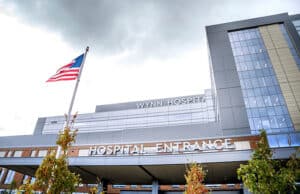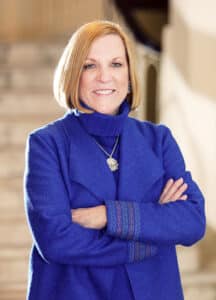CEO Darlene Stromstad, who is retiring at the end of the year, talks about the future of the health system
Whether it’s staffing and recruitment, acquiring new equipment and capabilities or a building project, large hospital systems in the Mohawk Valley agree on one thing — bringing world class quality of care to small towns in Upstate New York has its challenges. In this two-part project, leaders at the Mohawk Valley Health System and Bassett Healthcare Network talk about what it means to care for, and be a part of, the community.
By Jolene Cleaver

What happens after a hospital is built?
Hospital leaders at the Mohawk Valley Health System say the answer is simple: plan and maintain those plans for future growth in an ever-changing healthcare landscape.
Health system officials also add that now, with the completion of Wynn Hospital in the rearview mirror, primary focus is on healthcare delivery and staffing to meet current and future community needs.
Wynn

At the Utica-based healthcare network, planning for the now-completed Wynn Hospital has been in the works since 2017, MVHS president and CEO Darlene Stromstad said in an early April interview. Stromstad is in her last year as head of MVHS as she announced plans to retire by the end of the year. A search committee has been created by the MVHS board of directors to perform a national search to find her replacement.
Looking at her time with MVHS, Stromstad said the road to Wynn Hospital’s construction was a long one and very all hands-on-deck.
MVHS planners created full scale mock patient and operating rooms.
“So people could go in, they could stand around a bed. Practice on a mock patient. So they could see how they moved around,” Stromstad said.
More than 400 MVHS employees worked on a plan to build a hospital that met all standards, quiet environment, natural light, safety quality, convenience, noise, accessibility. Some features were drawn from experiences visiting other newer hospitals in the United States.
Did MVHS meet those expectations?
“I would say yes,” she said.
What’s next? 20 years down the road? Where do you go from here?
“The design of [Wynn] was meant to be timeless … should we need more beds, this building was designed so the room we are sitting in now could become patient space,” Stromstad said while sitting in her office. With the opening of the Wynn Hospital, plans are in various stages of completeness for the future uses of MVHS’s Faxton St. Lukes and St. Elizabeth’s hospital campuses.
Residency program
Like all other healthcare networks, the search is continually on for more medical staff and a lot of that work comes in the form of being a learning institution and home growing the next generation of healthcare workers through residency programs.
“We continue to see growth in the number of medical students and residents choosing MVHS and the Wynn Hospital for their training,” a statement from MVHS said. “Beyond our residency programs, we’re also seeing success at the medical student level. All 32 of our current fourth-year medical students matched into residency programs, and three matched into our own programs here at MVHS.”
Residency by the numbers
According to MVHS, with this year’s incoming class, the hospital system expects to have:
• 31 medical students from Lake Erie College of Osteopathic Medicine and University of New England College of Osteopathic Medicine
• At least 95 residents (possibly more)
• Thirty-nine of these residents will be first-year trainees.
Here is the expected breakdown of those residents by specialty:
• Family Medicine: 30
• General Surgery: 18
• Obstetrics and Gynecology: 12
• Psychiatry: 15
• Transitional Year: 12
• Pharmacy: 2
• Dental: 4
• Podiatry: 2
Stromstad retiring and lessons learned
In a late March announcement, Stromstad said her retirement will take effect some time in late 2025.
She will have been with the hospital system for seven years by the time she leaves.
“It has gone very fast, it’s been very busy,” she said, reflecting that one thing she has learned over the years is that in the healthcare field, success and challenge can walk hand in hand.
As an example, looking at recent history, Stromstad said that when the world was gripped in a COVID-19 pandemic for three years, “We learned we don’t control anything … we tried to follow the science and keep people safe.”
All the while, construction on Wynn Hospital continued, as it was deemed essential, but was slow going as limited numbers of construction workers could be on the site at one time due to social distancing guidelines.
Even when the second wave of the pandemic hit the Mohawk Valley area hard and the Mohawk Valley region had one of the highest admission rates in the state, MVHS went into full incident command. Thinking it would be two weeks, it ended up being three years.
But COVID-19 waned and the hospital came to fruition.
“Not everybody was supportive of a new hospital but everyone had an opinion. You come to expect that,” she said.
Looking to the future, she envisions downtown to continue to grow around the hospital as there’s more space to develop. Circling back, Stromstad said it’s the goal of MVHS to expand on the medical residency program to address the ongoing shortage in medical professionals, as well as continue to support St. Elizabeth’s college of nursing.
“Our goal is that this organization be the pride of Central New York. Oneida County is not getting younger. So we have to do what we can to get people interested in working in healthcare.”
Ever-changing healthcare landscape
From her current office located at Wynn in downtown Utica, she watches buses come and go. She can see the Wolfspeed semiconductor on the hill in nearby Marcy. She can see the pulse.
That pulse is only going to get stronger, and going into the future, after she leaves, MVHS will need to constantly stay light on its feet to steer the healthcare of its community, she said.
“When I joined MVHS, I was drawn to the opportunity to help transform healthcare in Central New York. Together, we accomplished something truly extraordinary with the opening of Wynn Hospital — a state-of-the-art facility that will serve this region for generations to come. We strengthened our system, expanded services and navigated challenges with resilience, all with the goal of improving the lives of those who rely on us for care,” Stromstad said at the time of her retirement announcement.

